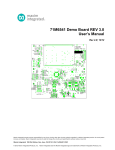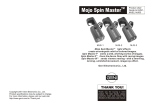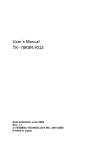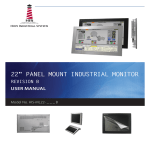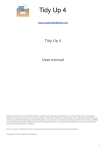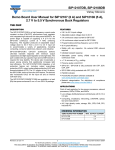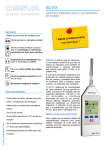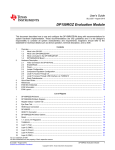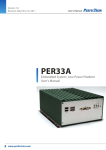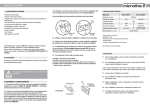Download SN65DSI86/SN65DSI96 EVM User`s Manual
Transcript
User's Guide SLLU204 – June 2014 SN65DSI86/SN65DSI96 EVM User’s Manual This guide describes how to use and configure the SN65DSI86 or SN65DSI96 EVM, with recommendations for system hardware implementation. These recommendations are only guidelines; the designer is responsible for all system characteristics and requirements. Refer to the datasheet for technical details such as device operation and terminal description. 1 2 3 4 5 6 7 Contents Overview ...................................................................................................................... 3 1.1 What are SN65DSI86 and SN65DSI96? ........................................................................ 3 1.2 What is the SN65DSIX6 EVM? ................................................................................... 3 1.3 What is Included in the SN65DSIX6 EVM? ..................................................................... 3 1.4 What does the EVM look like? .................................................................................... 4 Hardware Description ....................................................................................................... 6 2.1 Connectors for DSIX6 Input Ports ................................................................................ 6 2.2 Connectors for DSIX6 Output Ports .............................................................................. 8 2.3 I2C................................................................................................................... 10 2.4 Enable and Reset ................................................................................................. 10 2.5 Power ............................................................................................................... 10 2.6 Ambient Light Sensor ............................................................................................. 11 2.7 Reference CLK Programmability ................................................................................ 11 2.8 DIP Switch Configuration ......................................................................................... 11 Quick Start Guide .......................................................................................................... 12 References .................................................................................................................. 12 EVM Bill of Materials ....................................................................................................... 12 EVM Schematics ........................................................................................................... 15 Sample Total Phase Aardvark I2C Host Adapter Scripts ............................................................. 19 7.1 1920x1080 @60Hz 24bpp – DSI A Channel Only and 2 DP at HBR ...................................... 19 7.2 2560x1440 @60Hz 24bpp – Dual DSI Channels and 2 DP at HBR2 ...................................... 21 7.3 Enabling ASSR in Panel.......................................................................................... 23 List of Figures ........................................................................................... 1 SN65DSIX6EVM Rev1 or Rev2 2 SN65DSI8X EVM Rev 3 .................................................................................................... 5 3 SN65DSIX6 EVM Block Diagram .......................................................................................... 6 4 DSI86 EDP_30PIN 5 DSI86 EDP_40PIN ......................................................................................................... 10 6 DSI86/96 Rev1 EVM Example Setup .................................................................................... 12 7 SN65DSI86/96 EVM ....................................................................................................... 15 8 SN65DSI86/96 EVM ....................................................................................................... 16 9 SN65DSI86/96 EVM ....................................................................................................... 17 10 SN65DSI86/96 EVM ....................................................................................................... 18 11 SN65DSI86/96 EVM ....................................................................................................... 19 .......................................................................................................... 4 9 List of Tables 1 SN65DSIX6 Features Summary ........................................................................................... 3 2 J4 Pin-out ..................................................................................................................... 6 SLLU204 – June 2014 Submit Documentation Feedback SN65DSI86/SN65DSI96 EVM User’s Manual Copyright © 2014, Texas Instruments Incorporated 1 www.ti.com 2 3 J1 Pin-out ..................................................................................................................... 7 4 J1 Pin-out ..................................................................................................................... 8 5 J6 and J9 Selection Options 6 J6 Pin-out ..................................................................................................................... 8 7 DIP Switch Settings ........................................................................................................ 11 8 EVM Bill of Materials ....................................................................................................... 12 ............................................................................................... SN65DSI86/SN65DSI96 EVM User’s Manual Copyright © 2014, Texas Instruments Incorporated 8 SLLU204 – June 2014 Submit Documentation Feedback Overview www.ti.com 1 Overview 1.1 What are SN65DSI86 and SN65DSI96? The SN65DSI86 and SN65DSI96 devices are referred to as SN65DSIX6 in this document. SN65DSIX6 is a MIPI DSI to eDP bridge device that supports video modes in forward direction. The SN65DSIX6 targets portable applications such as tablets and smart phones that utilize the MIPI DSI video format. The SN65DSIX6 can be used between a GPU with DSI output and a video panel with DisplayPort inputs. Both devices share the same pin out and package. Table 1 is a summary of the feature sets on these devices: Table 1. SN65DSIX6 Features Summary Part Name 1.2 Description SN65DSI86 Dual channel DSI to 4 eDP lanes SN65DSI96 Dual channel DSI to 4 eDP lane with adaptive display technology What is the SN65DSIX6 EVM? The SN65DSIX6 EVM is a PCB created to help customers evaluate the SN65DSIX6 device for video applications with the DSI and DisplayPort interface. This EVM can also be used as a hardware reference design for any implementation of the SN65DSIX6. The SN65DSIX6 EVM is designed for both the SN65DSI86 and SN65DSI96 DSI bridge devices. NOTE: Note: Some portions and components in the EVM or in this document may include the references to SN65DSI86 instead of addressing both part numbers. For the purposes of this document, the SN65DSI86 is interchangeable with the SN65DSI96. PCB design and layout files are provided upon request to aid the PCB design with a SN65DSIX6 component. The layout files are a guideline for implementing the SN65DSIX6, with illustrations of the routing and placement rules. The EVM design includes test components to evaluate the SN65DSIX6 which may not applicable for production. 1.3 What is Included in the SN65DSIX6 EVM? The major components of the EVM are: • SN65DSI86ZQE or SN65DSI96ZQE • Samtec QSH type connectors on DSI and eDP interfaces • Standard DisplayPort connector • Hirose type connector on DSI Ch A interface • I2C programming interface for an external I2C host connection SLLU204 – June 2014 Submit Documentation Feedback SN65DSI86/SN65DSI96 EVM User’s Manual Copyright © 2014, Texas Instruments Incorporated 3 Overview 1.4 www.ti.com What does the EVM look like? Figure 1. SN65DSIX6EVM Rev1 or Rev2 4 SN65DSI86/SN65DSI96 EVM User’s Manual Copyright © 2014, Texas Instruments Incorporated SLLU204 – June 2014 Submit Documentation Feedback Overview www.ti.com Figure 2. SN65DSI8X EVM Rev 3 SLLU204 – June 2014 Submit Documentation Feedback SN65DSI86/SN65DSI96 EVM User’s Manual Copyright © 2014, Texas Instruments Incorporated 5 Hardware Description 2 www.ti.com Hardware Description DSI Input eDP Output SN65DSI86/96 EVM Berger 2 x 16 AUXP/N DSI_CHA_CLK ML[3:0]P/N DSI_CHA_DATAP/N[3:0] or SMA/ Samtec DP DSI_CHB_CLK DSI86/96 DSI_CHB_DATAP/N[3:0] Page 2 or HPD Samtec Page 3 Page 3 3.3 V 5V– 17 V 1.2 V Ambient Light Ref_CLK IN Page 5 1.8 V Page 6 I2C Logic Reset Logic Page 4 Page 4 CDC-RefCLK Generation Page 4 Figure 3. SN65DSIX6 EVM Block Diagram 2.1 Connectors for DSIX6 Input Ports The EVM has two input options for DSI video. If designing a custom breakout board using these options, a schematic and an allegro PCB symbol for either connector can be provided by TI upon request. 2.1.1 J4 - Samtec QSH Type Connector (P/N QSH-020-01-H-D-DP-A) J4 is a Samtec QSH-type connector that can be mated with a matching QTH type connector on the top. The J4 provides DSI input connections to both DSI Ch A and Ch B signals, and access to I2C and other miscellaneous signals such as IRQ. XC connections are open vias if a connection to other signals is required. The mating connector part number is QTH-020-01-H-D-DP-A. For an SMA type connection, a HDR-128291-XX breakout board from Samtec can be used. The HDR-128291-XX is a breakout board with a mating connector to J4 and standard SMA male connectors via cables. More info on this breakout board can be provided upon request. Note: Resistors R6 thru R15 should be unpopulated when using this connector. Failure to remove these resistors will result in signal integrity issues. These resistors are located on the bottom of PCB underneath J4. Table 2. J4 Pin-out 6 Pin# Name Pin# Name 1 DSI_A3P 2 DSI_B3P 3 DSI_A3N 4 DSI_B3N 5 GND 6 GND 7 GND 8 GND 9 DSI_A2P 10 DSI_B2P 11 DSI_A2N 12 DSI_B2N 13 GND 14 GND 15 GND 16 GND 17 DSI_ACLKP 18 DSI_BCLKP 19 DSI_ACLKN 20 DSI_BCLKN 21 GND 22 GND SN65DSI86/SN65DSI96 EVM User’s Manual Copyright © 2014, Texas Instruments Incorporated SLLU204 – June 2014 Submit Documentation Feedback Hardware Description www.ti.com Table 2. J4 Pin-out (continued) 2.1.2 Pin# Name Pin# Name 23 GND 24 GND 25 DSI_A1P 26 DSI_B1P 27 DSI_A1N 28 DSI_B1N 29 GND 30 GND 31 GND 32 GND 33 DSI_A0P 34 DSI_B0P 35 DSI_A0N 36 DSI_B0N 37 RESETN 38 IRQ 39 I2C_SDA 40 I2C_SCL J1 – Hirose FX Type Connector (P/N FX6A-40S-0.8SV2) J1 is a Hirose FX-type connector that can be mated with a matching FX plug on the top. The part number for the mating connector is FX6A-40P-0.8SV2. J1 provides a DSI input connection only to the DSI Ch A signals. J1 also provides access to I2C and other miscellaneous signals such as IRQ. This connector is only available in Revision 1 and 2 of the EVM. Table 3. J1 Pin-out 2.1.3 Pin# Name Pin# Name 1 NC 2 NC 3 NC 4 NC 5 NC 6 NC 7 NC 8 NC 9 GND 10 NC 11 DSI_ACLKP 12 GND 13 DSI_ACLKN 14 NC 15 GND 16 NC 17 DSI_A0P 18 I2C_SCL 19 DSI_A0N 20 I2C_SDA 21 GND 22 GND 23 DSI_A1P 24 IRQ 25 DSI_A1N 26 NC 27 GND 28 NC 29 DSI_A2P 30 NC 31 DSI_A2N 32 GND 33 GND 34 NC 35 DSI_A3P 36 NC 37 DSI_A3N 38 NC 39 GND 40 GND J1 – 100-mil Male Header J1 is a 2x16 100-mil male header. J1 provides DSI input connection only to the DSI Ch A signals. J1 also provides access to I2C and other miscellaneous signals such as IRQ. This connector is only available in Revision 3 of the EVM. SLLU204 – June 2014 Submit Documentation Feedback SN65DSI86/SN65DSI96 EVM User’s Manual Copyright © 2014, Texas Instruments Incorporated 7 Hardware Description www.ti.com Table 4. J1 Pin-out 2.2 Pin# Name Pin# 1 GND 2 Name GND 3 DSI_A0N 4 I2C_SCL 5 DSI_A0P 6 I2C_SDA 7 GND 8 GND 9 DSI_A1N 10 IRQ 11 DSI_A1P 12 NC 13 GND 14 GND 15 DSI_A2N 16 NC 17 DSI_A2P 18 NC 19 GND 20 GND 21 DSI_A3N 22 NC 23 DSI_A3P 24 NC 25 GND 26 GND 27 DSI_ACLKN 28 NC 29 DSI_ACLKP 30 NC 31 GND 32 GND Connectors for DSIX6 Output Ports There are two output port options available on the EVM for the DisplayPort output signals. By default, the DisplayPort interface signals from the SN65DSIX6 are connected to the J9 connector. To use the J6, follow these capacitor select options: Table 5. J6 and J9 Selection Options Component Install Requirement 2.2.1 J6 C63, C64, C65, C66, C67, C68, C69, C70, C71, C72 J9 (Default) C73, C74, C75, C76, C77, C78, C79, C80, C81, C82 J9 – Standard DisplayPort Male Connectors (Molex P/N 47272-0001) J9 is a standard DisplayPort male connector widely used in notebooks and desktops for interfacing to external DisplayPort capable monitors. DisplayPort cables for connecting to this connector and a external monitor can be obtained from a third party source. 2.2.2 J6 - Samtec QSH type Connector (P/N QSH-020-01-H-D-DP-A) J6 is a Samtec QSH-type connector that can be mated with a matching QTH-type connector on the top. The J6 provides DSI input connections to DisplayPort signals and accesses the back light power and its related signals. XC connections are open vias if a connection to other signals is required. The mating connector part number is QTH-020-01-H-D-DP-A. For an SMA-type connection, a HDR-128291-XX breakout board from Samtec can be used. The HDR-128291-XX is a breakout board with a mating connector to J6 and standard SMA male connectors via cables. More info on this breakout board can be obtained from the Samtec website. Table 6. J6 Pin-out Pin# 8 Name Pin# Name 1 ML3N 2 I2C_SDL (LVCMOS 3.3V Level) 3 ML3P 4 I2C_SDA (LVCMOS 3.3V Level) 5 GND 6 GND SN65DSI86/SN65DSI96 EVM User’s Manual Copyright © 2014, Texas Instruments Incorporated SLLU204 – June 2014 Submit Documentation Feedback Hardware Description www.ti.com Table 6. J6 Pin-out (continued) 2.2.2.1 Pin# Name Pin# Name 7 GND 8 GND LCD_VCC 9 ML2N 10 11 ML2P 12 LCD_VCC 13 GND 14 EDP SELF TEST 15 GND 16 HPD 17 ML1N 18 NC 19 ML1P 20 NC 21 GND 22 BL_ENABLE 23 GND 24 PWM_DIM 25 ML0N 26 NC 27 ML0P 28 NC 29 GND 30 GND 31 GND 32 GND 33 AUXP 34 BL_PWR 35 AUXN 36 BL_PWR 37 GND 38 BL_PWR 39 GND 40 BL_PWR J6 Daughterboards There are two daughterboards for connecting to eDP panels: DSI86 EDP_30PIN and DSI86 EDP_40PIN. These boards are not provided with the SN65DSI86/96 EVM board, but are available upon request. 2.2.2.1.1 DSI86 EDP_30PIN The DSI86 EDP_30PIN daughterboard supports up to 2 eDP lanes. This board is intended to mate to an eDP panel that has a pin-out that matches Table 6-3 in the VESA Embedded DisplayPort Standard Version 1.3. This board has a Samtec QTH-020-01-H-D-DP-A for mating to J6 on the SN65DSI86/96 EVM board and an IPEX receptacle (part# 20455-030E-02) for interfacing to an eDP panel. The ribbon cable for connecting the eDP panel to this daughterboard should use a IPEX plug (part# 20453-030T-11S) or equivalent. Figure 4. DSI86 EDP_30PIN SLLU204 – June 2014 Submit Documentation Feedback SN65DSI86/SN65DSI96 EVM User’s Manual Copyright © 2014, Texas Instruments Incorporated 9 Hardware Description 2.2.2.1.2 www.ti.com DSI86 EDP_40PIN The DSI86 EDP_40PIN daughterboard supports up to 4 eDP lanes. This board is intended to mate to an eDP panel that has a pin-out that matches Table 6-4 in the VESA Embedded DisplayPort Standard Version 1.3. This board has a Samtec QTH-020-01-H-D-DP-A for mating to J6 on the SN65DSI86/96 EVM board and an IPEX receptacle (part# 20455-040E-02) for interfacing to an eDP panel. The ribbon cable for connecting the eDP panel to this daughterboard should use a IPEX plug (part# 20453-040T-11S) or equivalent. Figure 5. DSI86 EDP_40PIN 2.3 I2C Access to I2C signals are provided via DSI input connectors J1, J4, J10, or J16. I2C signal levels should be at 1.8 V when the I2C interface is accessed through connectors J1, J4, or J16. 3.3 V to 1.8 V voltage translation is provided when an I2C host is connected through J10. A standalone external I2C host can connect via J10 for debug purposes. An example of an external I2C host controller is the Total Phase Aardvark I2C/SPI host adapter (Total Phase Part#: TP240141). Sample scripts for this I2C Host controller are provided in Section 7. 2.4 Enable and Reset There are three device enable and reset options for the EVM. • Supervisor circuitry option: This is the default configuration. The enable (EN) signal is held low until the power good (PG) from the 1.8V voltage regulator reaches a stable high voltage level, then the EN is released high. • RC timing option: The C10 external capacitor and internal resistor control the EN ramp time after the device is powered on. C10 is a DNI (Do Not Install option) by default. C10 must be installed and R52 must be uninstalled to enable this option. • External control option: A push-button (SW1) or a J16 pin 9 is available for the manual control of the EN signal. 2.5 Power The 5 V-17 V power supply can be used to operate the SN65DSIX6 EVM. A plug to accept a 5 V to 17 V wall power adapter is provided on the EVM (J13). The EVM is designed to accommodate a maximum current of 1.5 A. The current consumption of the board without the back light driver enabled is about 75 mA + SN65DSIX6 device power. The SN65DSIX6 consumes about 23 mW at power on, and up to 320 mW depending on the system configurations. The total power consumption of the board could vary depending on the LCD panels when the on-board back light driver is used. When an LCD panel consumes more current than 1.5 A minus 75 mA + SN65DSIX6 device power, the external back light source should be used. 10 SN65DSI86/SN65DSI96 EVM User’s Manual Copyright © 2014, Texas Instruments Incorporated SLLU204 – June 2014 Submit Documentation Feedback Hardware Description www.ti.com Important: Do not plug in any power source higher than the configured voltage (17-V). 2.6 Ambient Light Sensor The SN65DSIX6 EVM incorporates a TAOS TSL2561T ambient light sensor. An external GPU can use this sensor with the SN65DSI96. By default, the sensor is located at the I2C slave address of 0x29 (R188 installed and R189 uninstalled). The I2C slave address can be changed to 0x49 (uninstall R188 and install R189) or 0x39 by (uninstall R188 and uninstall R189). 2.7 Reference CLK Programmability The SN65DSIX6 EVM incorporates programmable CLK circuitry using TI-programmable device CDCEL913. The output of the CDCEL913 is connected to the reference CLK of the SN65DSIX6. The CLK can be programmed via I2C signals brought out to on-board connectors J9, J12 or J10. When J10 is used, jumpers should be placed on J9 and J12. The default frequency of the REFCLK is set to 27MHz. 2.8 DIP Switch Configuration The DIP switch lets the user operate the device and EVM in different configurations. When the switch is in an open position, the corresponding signal is tied high. When the switch is in ON (closed) position, the corresponding signal is tied to GND. Table 7. DIP Switch Settings DEFAULT CONFIG DIP SW No Signal Name Description Open(Off) HIGH GPIO1 General Purpose I/O. Defaults to Input. Also used to select REFCLK frequency. X SW2-2 GPIO2 General Purpose I/O. Defaults to Input. Also used to select REFCLK frequency. X SW2-3 GPIO3 General Purpose I/O. Defaults to Input. Also used to select REFCLK frequency. SW2-4 GPIO4 General Purpose I/O. Defaults to Input. Also used to select REFCLK frequency. SW2-1 Closed(On) LOW X X Sets the I2C slave address of the SN65DSIX6 by controlling the ADDR pin. High = 0x2D (default) Low = 0x2C SW2-5 ADDR SW2-6 TEST1 Reserved. Texas Instruments use only X SW2-7 TEST2 Reserved. Texas Instruments use only. For DP compliance testing make dip switch position to OFF (high). X SW2-8 I2C_3V3EN Enables 3.3V voltage translator for the I2C signals SLLU204 – June 2014 Submit Documentation Feedback X X SN65DSI86/SN65DSI96 EVM User’s Manual Copyright © 2014, Texas Instruments Incorporated 11 Quick Start Guide 3 www.ti.com Quick Start Guide 1. Plug in a DSI source to J1 or J4. Refer to Section 2.1 for details on these connectors. All used DSI inputs should be held at LP11 state during this step. 2. Plug in a DisplayPort video sink device on J9 (Standard DisplayPort connector) or J6 (eDP breakout connector). Refer to Section 2.2 for details on these connectors. 3. Plug in an I2C host on J10 if using an external I2C host. 4. Correctly configure the DIP switch setting. 5. Apply power to the EVM. The following LEDS should light up: D3 and D6. D1 may light up depending on the configuration. 6. Configure the device for the desired mode of operation via I2C. Example Aardvark scripts are provided in Section 7. 7. Start video streaming on the DSI input. 8. Video output should be observed after the configuration is complete. Figure 6. DSI86/96 Rev1 EVM Example Setup 4 References SN65DSIX6 Datasheet. 5 EVM Bill of Materials Table 8. EVM Bill of Materials Item 12 Quantity Reference Part 1 7 C1, C38, C39, C42, C45, C46, C57 10uF 2 5 C2, C11, C28, C83, C91 1.0uF SN65DSI86/SN65DSI96 EVM User’s Manual Copyright © 2014, Texas Instruments Incorporated Manuf Manuf PN SLLU204 – June 2014 Submit Documentation Feedback EVM Bill of Materials www.ti.com Table 8. EVM Bill of Materials (continued) Item Quantity Reference Part 3 21 C3, C4, C6, C7, C9, C56, C59, C61, C62, C73, C74, C75, C76, C77, C78, C79, C80, C81, C82, C89, C90 Manuf Manuf PN 0.1uF 4 4 C5, C8, C58, C60 0.01uF 5 12 C10, C63, C64, C65, C66, C67, C68, C69, C70, C71, C72, C84 DNI 6 1 C22 220pF 7 10 C23, C29, C30, C31, C32, C33, C85, C86, C87, C88 0.1uF 8 1 C24 18pF 9 5 C25, C26, C44, C48, C55 DNI 10 2 C27, C37 22uF 11 1 C35 10uF Murata GRM21BR61E106K A73L 12 1 C36 22uF Murata GRM31CR61E226K E15L 13 1 C40 3.3nF 14 2 C43, C47 0.01uF 15 1 D1 LED Orange 0805 Rohm SML-211DTT86 16 1 D3 LED Green 0805 Arrow (Lumex) 670-1006 (SML_LX0805GC) 17 18 1 D6 LED RED 0805 Rohm SML-211UT 1 D8 20V, 1A Comchip CDBA120SL-G 19 1 FB4 220 @ 100MHZ Murata BLM18EG221SN1D 20 1 J1 2x16 Male Header Sullins PBC16DAAN QSH-020-01 Samtec QSH-020-01-X-DDP-A 21 2 J4, J6 22 3 J7, J8, J11 HDR2X1 M .1 AMP 103321-2 Molex 47272-0001 CUI STACK PJ-202AH 23 1 J9 Display_Port_Conn ector 24 1 J10 Header 5x2 0.1" thru-hole 25 1 J13 2.1mm x 5.5mm 26 4 J14, J17, J20, J21 HDR2X1 M .1 27 1 J16 HEADER 1x10 28 2 J18, J19 HDR3X1 M .1 29 8 LP1, LP2, LP3, LP4, LP5, LP6, LP7, LP9 LP KOBIKONN 151-103-RC 30 1 L1 2.2uH Vishay IHLP1616ABER2R2 M11 31 2 R1, R53 1K 32 2 R1, R53 350 16 R3, R4, R54, R55, R56, R57, R58, R59, R60, R61, R77, R78, R79, R87, R188, R191 4.7K 33 SLLU204 – June 2014 Submit Documentation Feedback SN65DSI86/SN65DSI96 EVM User’s Manual Copyright © 2014, Texas Instruments Incorporated 13 EVM Bill of Materials www.ti.com Table 8. EVM Bill of Materials (continued) Item Quantity Reference Part 34 1 R5 10nF 35 11 R6, R7, R8 ,R9, R10, R11, R12, R13, R14, R15, R70 0 36 7 R16, R51, R66, R112, R116, R117, R189 DNI 37 5 R27, R83, R113, R114, R115 100K 38 14 R29, R52, R75, R76, R80, R88, R104, R108, R109, R110, R111, R118, R186, R187 0 39 2 R33, R36 1M 40 1 R67 18 41 5 R72, R73, R74, R86, R103 10K 42 1 R81 500 43 1 R82 2.49K 44 1 R84 4.99K 45 1 R89 3.57K 46 1 R90 2.87K 47 1 R105 DNI 48 1 R192 4k 49 1 SW1 50 1 SW2 51 1 52 3 53 1 U1 SN65DSI86 TI SN65DSI86ZQER 54 1 U2 SN74LVC1G07DCK TI SN74LVC1G07DCK 55 1 U3 TPS3808 TI TPS3808g18DBVT 56 1 U4 SN74LVC1G08DCK TI SN74LVC1G08DCK 57 1 U5 CDCEL913PW TI CDCEL913PW 58 1 U6 TXS0102DCUT TI TXS0102DCUT 59 2 U8, U9 Manuf PN PB_SWITCH OMRON B3SN-3012P 8-POS 50-MIL SMT C&K(ITTCANNON) TDA08H0SK1R SW6 TS01CQE C&K Div. TS01CQE TP1, TP5, TP6 T POINT S TPS74201RGWT TI TPS74401RGWT TI SN74AVC1T45DCK R TSL2561T 60 2 U11, U12 SN74AVC1T45DCK R 61 1 U13 TSL2561T TAOS 62 1 U14 TPS62142RGTR TI TPS62142RGTR ABRACON ABM8-27.000MHZ10-1-U-T 63 14 Manuf 1 Y1 27MHZ _crystal SN65DSI86/SN65DSI96 EVM User’s Manual Copyright © 2014, Texas Instruments Incorporated SLLU204 – June 2014 Submit Documentation Feedback EVM Schematics www.ti.com 6 EVM Schematics The following pages contain schematics for the SN65DSI86/96 EVM. BOARD_1P8V LP1 LP2 Note: Bypass caps should be placed near U1 SN65DSI86. LP3 VCCIO 0 r0402 5% VCC BOARD_1P2V LP7 R108 ********Layout Notes******* For all differential pairs(DSI and DisplayPort) in this design follow the guidelines decribed below: Route together with controlled differential 100ohm impedance and controlled single ended 50ohm impedance. Keep away from other high speed signals especially all MLxP/N* signals. Keep lengths within 5mil of each other. Keep traces on layers adjacent to the ground plane. Keep the number of VIAS to minimum. If VIAS used, make it symetrical through all signals. Keep diff pairs separated at least by x3 of the trace width. NO STUBS on the signal path, components should be placed such that the signals can routed in pass-thru manner. R109 C1 10uF C4 C6 C62 0.1uF 0.1uF 0.1uF 0 r0402 5% C2 C3 C5 C7 1.0uF 0.1uF 0.01uF 0.1uF LP9 VCCA R110 C61 0.1uF 0 r0402 5% C57 10uF C11 C56 C58 C59 C60 1.0uF 0.1uF 0.01uF 0.1uF 0.01uF BOARD_1P8V SilkScreen: BOARD_3P3V IRQ C9 TP1 T POINT S R1 1K 5 0.1uF 2 IRQ U2 SN74LVC1G07DCK 4 IRQ_OUT 3 1 350 r0402 5% 2 SilkScreen: REF_CLK IRQ D1 IRQ_LED Reset Implementation BOARD_RESETN SilkScreen: R2 LED Orange 0805 J17 HDR2X1 M .1 1 C10 DNI 0.2uF EXT_REFCLK VCCIO VCC VCCA *IMPORTANT* If REFCLK is to be used, the CLK trace length between the REFCLK terminal and the source of the REF CLK(OSC or Xtal) should be kept as short as possble. r0402 R118 0 5% BOARD_1P8V BOARD_1P8V R104 and R105 have a shared footprint node Vpll Vccio Vccio BOARD_RESETN A1 PG4 ADDR PG4 PG4 TEST1 TEST2 PG3 PG3 PG3 PG3 PG3 PG3 PG3 PG3 PG3 PG3 DSI_A0P DSI_A0N DSI_A1P DSI_A1N DSI_A2P DSI_A2N DSI_A3P DSI_A3N DSI_ACLKP DSI_ACLKN PG3 PG3 PG3 PG3 PG3 PG3 PG3 PG3 PG3 PG3 DSI_B0P DSI_B0N DSI_B1P DSI_B1N DSI_B2P DSI_B2N DSI_B3P DSI_B3N DSI_BCLKP DSI_BCLKN B3 B5 H3 J3 H4 J4 H6 J6 H7 J7 H5 J5 DSI_B0P DSI_B0N DSI_B1P DSI_B1N DSI_B2P DSI_B2N DSI_B3P DSI_B3N DSI_BCLKP DSI_BCLKN C2 C1 D2 D1 F2 F1 G2 G1 E2 E1 REFCLK ADDR SCL SDA TEST1 TEST2 IRQ DA0P DA0N DA1P DA1N DA2P DA2N DA3P DA3N DACP DACN ML3N ML3P ML2N ML2P ML1N ML1P ML0N ML0P DB0P DB0N DB1P DB1N DB2P DB2N DB3P DB3N DBCP DBCN AUXP AUXN HPD GPIO4 GPIO3 GPIO2 GPIO1 A8 D8 E4 E5 F4 F5 F6 G8 DSI INPUT DSI_A0P DSI_A0N DSI_A1P DSI_A1N DSI_A2P DSI_A2N DSI_A3P DSI_A3N DSI_ACLKP DSI_ACLKN EN GND GND GND GND GND GND GND GND PG3,4 B1 R3 4.7K A9 G9 E6 B2 H2 0.01uF R4 4.7K R105 DNI r0402 1% Vcca Vcca Vcca Vcca Vcca C8 0.1uF D6 D5 J2 J9 C90 1.0uF Vcc Vcc Vcc Vcc C91 D9 B6 A2 VDDPLL U1 ADDR = 1, Slave Addr = 0x2D (0101101) ADDR = 0, Slave Addr = 0x2C (0101100) Place as near as possible to REFCLK terminal on U1 SN65DSI86/96 Reset(EN) can be implemented with passive components as shown or active circuitry. In case of using passive components, the values of the RC circuitry need to be adjusted to make sure the low to high transition occurs after the Vcc supply has reached the minimum recommended operating voltage. For this reason, it is recommended to USE ACTIVE CIRCUITRY for better control of the RESET/EN timing. NC A7 0 RREFCLK R104 H1 J1 I2C_SCL I2C_SDA A3 IRQ IRQ r0402 5% REFCLK PG4 PG3,4 PG3,4 PG3 B9 B8 ML3N ML3P C63 DNI C64 DNI EDP_ML3N EDP_ML3P PG3 PG3 C9 C8 ML2N ML2P C65 DNI C66 DNI EDP_ML2N EDP_ML2P PG3 PG3 E9 E8 ML1N ML1P C67 DNI C68 DNI EDP_ML1N EDP_ML1P PG3 PG3 F9 F8 ML0N ML0P C69 DNI C70 DNI EDP_ML0N EDP_ML0P PG3 PG3 AUXP AUXN C71 DNI C72 DNI EDP_AUXP EDP_AUXN 0.1uF C74 0.1uF DP_ML3N DP_ML3P PG3 PG3 C75 0.1uF C76 0.1uF DP_ML2N DP_ML2P PG3 PG3 C77 0.1uF C78 0.1uF DP_ML1N DP_ML1P PG3 PG3 0.1uF C80 0.1uF DP_ML0N DP_ML0P PG3 PG3 0.1uF C82 0.1uF DP_AUXP DP_AUXN PG3 PG3 H8 H9 J8 RHPD R111 0 B4 A6 A5 A4 HPD GPIO4 GPIO3 GPIO2 GPIO1 B7 AMUX PG3,4 PG3,4 PG4 PG4 C73 XC17 C84 SN65DSI86 PG3,4 C79 DNI R5 10nF C81 PG3 PG3 ES1 Device: - R111 populate with 0-ohm resistor - R5 populate with 10nF capacitor. Production Device: - R111 populate with 51K 1% resistor - R5 should be a DNI SN65DSI86/96 SIZE C SCALE: NONE DWG NO: T uesday, March 26, 2013 Sheet 2 of 6 Figure 7. SN65DSI86/96 EVM SLLU204 – June 2014 Submit Documentation Feedback SN65DSI86/SN65DSI96 EVM User’s Manual Copyright © 2014, Texas Instruments Incorporated 15 EVM Schematics www.ti.com DSI ChA Display Expansion Connector BOARD_9V BOARD_3P3V J1 PG2,3 PG2,3 DSI_A0N DSI_A0P PG2,3 PG2,3 DSI_A1N DSI_A1P PG2,3 PG2,3 DSI_A2N DSI_A2P PG2,3 PG2,3 DSI_A3N DSI_A3P PG2,3 PG2,3 DSI_ACLKN DSI_ACLKP R9 0 R8 0 R11 0 R10 0 R13 0 R12 0 R15 0 R14 0 R7 0 R6 0 1 3 5 7 9 11 13 15 17 19 21 23 25 27 29 31 FX_N0 FX_P0 r0201 r0201 FX_N1 FX_P1 r0201 r0201 FX_N2 FX_P2 r0201 r0201 FX_N3 FX_P3 r0201 r0201 FX_CLKN FX_CLKP r0201 r0201 1 3 5 7 9 11 13 15 17 19 21 23 25 27 29 31 2 4 6 8 10 12 14 16 18 20 22 24 26 28 30 32 J6 2 4 6 8 10 12 14 16 18 20 22 24 26 28 30 32 R114 100K J20 I2C_SCL I2C_SDA R16 DNI r0402 IRQ PG2,3,4 PG2,3,4 2 PG2,3 1 40 38 36 34 32 30 28 26 24 22 20 18 16 14 12 10 8 6 4 2 EDP_BL_PWR HDR2X1 M .1 EDP_PWM_DIM EDP_BL_ENABLE BOARD_3P3V R192 4K J21 2 2x16 Header Male 1 HDR2X1 M .1 PG4,5 PG4,5 HPD EDP_SELF_TEST EDP_LCD_VCC I2C_SDA_3P3V I2C_SCL_3P3V R116 R117 DNI DNI 39 37 35 33 31 29 27 25 23 21 19 17 15 13 11 9 7 5 3 1 C_EDPTX_AUXN C_EDPTX_AUXP C_EDPTX_LN0P C_EDPTX_LN0N C_EDPTX_LN1P C_EDPTX_LN1N C_EDPTX_LN2P C_EDPTX_LN2N C_EDPTX_LN3P C_EDPTX_LN3N EDP_AUXN EDP_AUXP PG2 PG2 EDP_ML0P EDP_ML0N PG2 PG2 EDP_ML1P EDP_ML1N PG2 PG2 EDP_ML2P EDP_ML2N PG2 PG2 EDP_ML3P EDP_ML3N PG2 PG2 G3 G4 G1 G2 TOP R115 100K QSH-020-01 NOTE: - Remove R6-R15 for DSI source connected to J4 - Populate R6-R15 w hen a source connected through J1 **R6 - R15 to be placed as near as J4 to avoid stub w hen J1 is not in use** Samtec to SMA Connector for DSIA and DSIB NOTE: Add mounting holes as instructed in the layout notes. J4 PG2,3,4 PG2,3 PG2 PG2 I2C_SCL IRQ DSI_B0N DSI_B0P PG2 PG2 DSI_B1N DSI_B1P PG2 PG2 DSI_BCLKN DSI_BCLKP PG2 PG2 DSI_B2N DSI_B2P PG2 PG2 DSI_B3N DSI_B3P 0 r0201 R70 BOARD_3P3V QSH-020-01 40 38 36 34 32 30 28 26 24 22 20 18 16 14 12 10 8 6 4 2 39 37 35 33 31 29 27 25 23 21 19 17 15 13 11 9 7 5 3 1 R29 I2C_SDA PG2,3,4 BOARD_RESETN PG2,4 DSI_A0N PG2,3 DSI_A0P PG2,3 0 DSI_A1N DSI_A1P DSI_ACLKN DSI_ACLKP PG2,3 PG2,3 PG2,3 PG2,3 DSI_A2N DSI_A2P PG2,3 PG2,3 DSI_A3N DSI_A3P PG2,3 PG2,3 J9 G3 G4 G1 G2 TOP NOTE: This connector is to interface DSI interface w ith any source w ith SMA connectors via Samtec to SMA cable DPTX_GND 24 23 22 21 C83 R33 1M r0402 5% BOARD_3P3V BOARD_1P8V C85 DP_PWR RTN HPD AUX_n GND6 AUX_p GND5 CAD ML_3n GND4 ML_3p ML_2n GND3 ML_2p ML_1n GND2 GND10 ML_1p GND9 ML_0n GND8 GND1 GND7 ML_0p 20 19 18 17 16 15 14 13 12 11 10 9 8 7 6 5 4 3 2 1 R112 DNI R27 100K r0402 HPD DP_AUXN PG2,4 PG2 DP_AUXP PG2 DPTX_CAD DP_ML3N PG2 DP_ML3P DP_ML2N PG2 PG2 DP_ML2P DP_ML1N PG2 PG2 DP_ML1P DP_ML0N PG2 PG2 DP_ML0P PG2 Display _Port_Connector_Source 1.0uF R36 1M r0402 5% R113 100K C86 0.1uF 0.1uF U11 R186 EDP_BL_ENABLE 1 0 r0402 5% 3 EDP_BL_ENABLE_R 6 VCCA VCCB A 5 DIR 4 B GPIO3 PG2,4 GPIO4 PG2,4 2 GND SN74AVC1T45DCKR DIR L = B to A DIR H = A to B BOARD_3P3V BOARD_1P8V C87 C88 0.1uF 0.1uF U12 R187 EDP_PWM_DIM 1 0 r0402 5% EDP_PWM_DIM_R 3 5 VCCA VCCB A DIR B GND 6 4 2 SN74AVC1T45DCKR DIR L = B to A DIR H = A to B Figure 8. SN65DSI86/96 EVM 16 SN65DSI86/SN65DSI96 EVM User’s Manual Copyright © 2014, Texas Instruments Incorporated SLLU204 – June 2014 Submit Documentation Feedback EVM Schematics www.ti.com J16 1 2 3 4 5 6 7 8 9 10 RESET BOARD_1P8V BOARD_1P8V R51 DNI r0402 5% PG2,3 BOARD_RESETN BOARD_RESETN GPIO1 GPIO2 GPIO3 GPIO4 ADDR I2C_SDA I2C_SCL r0402 U3 RESET# GND MR# VDD SENSE CT 6 5 4 CT DIPSW C22 C23 220pF 0.1uF BOARD_1P8V BOARD_1P8V Note: Place caps near the part. R54 4.7K r0402 5% U4 SN74LVC1G08DCK 5 1 PG BOARD_3P3V BOARD_1P8V R53 1K r0402 5% Vcc R55 4.7K r0402 5% R56 4.7K r0402 5% R57 4.7K r0402 5% R58 4.7K r0402 5% R59 4.7K r0402 5% R60 4.7K r0402 5% R61 4.7K r0402 5% 4 2 SW1 PB_SWITCH 1 2 PG2 PG2 PG2,3 PG2,3 PG2 PG2 PG2 3 4 3 N.O. C24 18pF SilkScreen: PG2,3 HEADER 1x10 1 2 3 RESET# R52 0 TPS3808 TPS3808g18DBVT PG6 HPD BOARD_RESETN RESET GPIO1 GPIO2 GPIO3 GPIO4 ADDR TEST1 TEST2 I2C_3V3EN TEST1 and TEST2 for Texas Instruments internal use only. TEST1 shall be left unconnected or tied to GND. TEST2 shall be left unconnected or tied to GND. For DP compliance testing, TEST2 needs to be pulled up to 1.8V. SW2 8-POS 50-MIL SMT C&K (ITT-CANNON) TDA08H0SK1R 16 1 15 2 14 3 13 4 12 5 11 6 10 7 9 8 SilkScreen: GPIO1 GPIO2 GPIO3 GPIO4 ADDR TEST1 TEST2 I2C_3V3EN I2C CDC C25 CDC_XIN DNI R66 DNI r0402 5% FB4 220 @ 100MHZ CDC_XOUT 2 13 12 BOARD_1P8V XOUT VDD VDDOUT VDDOUT VCTR Y1 S0 S1_SDA S2_SCL Y2 CDCEL913PW GND GND 4 XIN_CLK R74 10K r0402 5% CDC_VDD 6 7 11 R67 REFCLK CDC_Y1 9 1 C28 C29 1.0uF 0.1uF I2C_SDA_3P3V I2C_SCL_3P3V 8 1 2 BOARD_3P3V VCCB VCCA 0.1uF B1 B2 A1 A2 GND OE 3 5 4 A1_SDA A1_SCL R75 R76 6 0 0 I2C_SDA I2C_SCL PG2,3 PG2,3 I2C_3V3EN txs0102dcut C31 C32 C33 0.1uF 0.1uF 0.1uF C55 R77 4.7K r0402 5% SilkScreen: R78 4.7K r0402 5% SilkScreen: I2C J10 2 1 3 5 7 9 CDC_S0 J8 1 C30 BOARD_3P3V HDR2X1 M .1 CDC_S1_SDA Note: Place caps near the part. 7 PG2 PLACE CLOSE TO U5 8 BOARD_1P8V BOARD_3P3V U6 18 r0402 1% DNI J7 CDC_S0 Y3 3 5 10 14 R73 10K r0402 5% C27 22uF U5 1 DNI R72 10K r0402 5% Note: Place caps near the part. BOARD_1P8V Y1 27MHZ _cry stal C26 PG3,5 PG3,5 2 I2C_SDA_3P3V I2C_SCL_3P3V 2 4 6 8 10 GND CDC_S1 Header 5x2 0.1" thru-hole HDR2X1 M .1 1 2 3 I2C_SDA SilkScreen: CDC_SDA_ON CDC_S2_SCL GND J18 HDR3X1 M .1 J11 1 2 NOTE: SHUNT on CDC_SDA and CDC_SCL pin1 and 2 if external I2C host via J10 for I2C programming of CDC device CDC_S2 HDR2X1 M .1 1 2 3 I2C_SCL SilkScreen: CDC_SCL_ON GND J19 HDR3X1 M .1 RESET AND CDC SIZE C SCALE: NONE DWG NO: Friday, September 06, 2013 Sheet 4 of 6 Figure 9. SN65DSI86/96 EVM SLLU204 – June 2014 Submit Documentation Feedback SN65DSI86/SN65DSI96 EVM User’s Manual Copyright © 2014, Texas Instruments Incorporated 17 EVM Schematics www.ti.com BOARD_3P3V BOARD_3P3V R191 4.7K r0402 5% C89 0.1uF TSL_INT R189 DNI r0402 5% U13 1 5 3 VDD SDA SCL 6 4 I2C_SDA_3P3V I2C_SCL_3P3V 2 TSL_A0 I2C_SDA_3P3V I2C_SCL_3P3V PG3,4 PG3,4 INT GND ASEL TSL2561T R188 4.7K r0402 5% I2C SLAVE ADDRESS: 0x29 or 0101001 (ASEL = 0) 0x39 or 0111001 (ASEL = float) 0x49 or 1000101 (ASEL = 1) AMBIENT LIGHT SENSOR SIZE A SCALE: NONE DWG NO: T hursday, November 01, 2012 Sheet 5 of 6 Figure 10. SN65DSI86/96 EVM 18 SN65DSI86/SN65DSI96 EVM User’s Manual Copyright © 2014, Texas Instruments Incorporated SLLU204 – June 2014 Submit Documentation Feedback Sample Total Phase Aardvark I2C Host Adapter Scripts www.ti.com 1.2V REGULATOR SilkScreen: ON OFF BOARD_9V BOARD_3P3V BOARD_1P2V 1 2 3 SW6 TS01CQE 2 D8 R81 500 r0402 5% 1 PWRIN_SW J13 S T 20V, 1A 2.1mm x 5.5mm U8 5V to 17V SilkScreen: 5 6 7 8 C39 10uF R79 4.7K r0402 5% EN1P2 D3 LED Green 0805 9V 10 11 IN IN IN IN PG OUT OUT OUT OUT BIAS EN FB C43 0.01uF SS1P2 15 9 SS PG1P2 R80 PG 0 1 20 19 18 R82 2.49K r0402 1% 16 FB_1PT2V NC NC NC NC NC NC GND PAD 9V_DIODE LED9V 2 3 1 2 3 4 13 14 17 12 21 TPS74201RGWT C42 10uF R84 4.99K r0402 1% C44 DNI BOARD_9V BOARD_3P3V 3.3V REGULATOR BOARD_3P3V BOARD_1P8V LP6 1.8V REGULATOR L1 R103 10K r0402 5% U14 C35 10uF 10 R86 10K r0402 2 SW1 SW2 SW3 AVIN VOS 13 SS_TR J14 HDR2X1 M .1 PVIN1 PVIN2 9 8 C40 3.3nF 7 EN PG FB SS_TR DEF FSW PGND PGND AGND AGND 1 2 3 SWOUT 2.2uH 14 4 PG3P3 R83 100K r0402 5% C37 22uF C38 10uF 5 15 16 17 6 U9 R101 350 r0402 5% 5 6 7 8 C45 10uF R87 4.7K r0402 5% EN1P8 D6 LED RED 0805 1 11 PG OUT OUT OUT OUT BIAS EN FB C47 SilkScreen: 3P3V TPS62142RGTR 10 IN IN IN IN 0.01uF SS1P8 15 NC NC NC NC NC NC GND PAD 12 11 C36 22uF SS 2 3 4 13 14 17 12 21 TPS74201RGWT C48 DNI 9 PG1P8 R88 0 PG PG PG4 1 20 19 18 16 FB_1PT8V R89 3.57K r0402 1% C46 10uF R90 2.87K r0402 1% TO BE PLACED ACROSS PCB AS CONVENIENT FOR OSCILLOSCOPE PROBE GROUNDS SilkScreen: GND SilkScreen: TP5 T POINT S SilkScreen: GND SilkScreen: LP4 GND TP6 T POINT S GND LP5 POWER SIZE C SCALE: NONE DWG NO: T uesday, December 11, 2012 Sheet 6 of 6 Figure 11. SN65DSI86/96 EVM 7 Sample Total Phase Aardvark I2C Host Adapter Scripts 7.1 1920x1080 @60Hz 24bpp – DSI A Channel Only and 2 DP at HBR <aardvark> <configure i2c="1" spi="1" gpio="0" tpower="1" pullups="0" /> <i2c_bitrate khz="100" /> ======Single 4 DSI lanes====== <i2c_write addr="0x2D" count="1" radix="16">10 26</i2c_write> <sleep ms="10" /> ======enhanced framing====== <i2c_write addr="0x2D" count="1" radix="16">5A 04</i2c_write> <sleep ms="10" /> ======Pre0dB 2 lanes no SSC====== <i2c_write addr="0x2D" count="1" radix="16">93 20</i2c_write> SLLU204 – June 2014 Submit Documentation Feedback SN65DSI86/SN65DSI96 EVM User’s Manual Copyright © 2014, Texas Instruments Incorporated 19 Sample Total Phase Aardvark I2C Host Adapter Scripts www.ti.com <sleep ms="10" /> ======L0mV HBR====== <i2c_write addr="0x2D" count="1" radix="16">94 80</i2c_write> <sleep ms="10" /> ======PLL ENABLE====== <i2c_write addr="0x2D" count="1" radix="16">0D 01</i2c_write> <sleep ms="10" /> ======POST2 0dB ====== <i2c_write addr="0x2D" count="1" radix="16">95 00</i2c_write> <sleep ms="10" /> ======Semi-Auto TRAIN ====== <i2c_write addr="0x2D" count="1" radix="16">96 0A</i2c_write> <sleep ms="20" /> ======ADDR 0x96 CFR====== <i2c_write addr="0x2D" count="0" radix="16">96</i2c_write> <sleep ms="20" /> ======Read====== <i2c_read addr="0x2D" count="1" radix="16">00</i2c_read> <sleep ms="10" /> =====CHA_ACTIVE_LINE_LENGTH======= <i2c_write addr="0x2D" count="2" radix="16">20 80 07</i2c_write> <sleep ms="10" /> =====CHA_VERTICAL_DISPLAY_SIZE======= <i2c_write addr="0x2D" count="2" radix="16">24 38 04</i2c_write> <sleep ms="10" /> =====CHA_HSYNC_PULSE_WIDTH======= <i2c_write addr="0x2D" count="2" radix="16">2C 10 80</i2c_write> <sleep ms="10" /> =====CHA_VSYNC_PULSE_WIDTH======= <i2c_write addr="0x2D" count="2" radix="16">30 0E 80</i2c_write> <sleep ms="10" /> =====CHA_HORIZONTAL_BACK_PORCH======= <i2c_write addr="0x2D" count="1" radix="16">34 98</i2c_write> <sleep ms="10" /> =====CHA_VERTICAL_BACK_PORCH======= <i2c_write addr="0x2D" count="1" radix="16">36 13</i2c_write> <sleep ms="10" /> =====CHA_HORIZONTAL_FRONT_PORCH======= <i2c_write addr="0x2D" count="1" radix="16">38 10</i2c_write> 20 SN65DSI86/SN65DSI96 EVM User’s Manual Copyright © 2014, Texas Instruments Incorporated SLLU204 – June 2014 Submit Documentation Feedback Sample Total Phase Aardvark I2C Host Adapter Scripts www.ti.com <sleep ms="10" /> =====CHA_VERTICAL_FRONT_PORCH======= <i2c_write addr="0x2D" count="1" radix="16">3A 03</i2c_write> <sleep ms="10" /> ======DP-18BPP Enable====== <i2c_write addr="0x2D" count="1" radix="16">5B 00</i2c_write> <sleep ms="10" /> =====COLOR BAR ======= <i2c_write addr="0x2D" count="1" radix="16">3C 00</i2c_write> <sleep ms="10" /> ======enhanced framing and Vstream enable====== <i2c_write addr="0x2D" count="1" radix="16">5A 0C</i2c_write> <sleep ms="10" /> </aardvark> 7.2 2560x1440 @60Hz 24bpp – Dual DSI Channels and 2 DP at HBR2 <aardvark> <configure i2c="1" spi="1" gpio="0" tpower="1" pullups="0" /> <i2c_bitrate khz="100" /> ======Dual 4 DSI lanes====== <i2c_write addr="0x2D" count="1" radix="16">10 00</i2c_write> <sleep ms="10" /> ======enhanced framing====== <i2c_write addr="0x2D" count="1" radix="16">5A 04</i2c_write> <sleep ms="10" /> ======Pre0dB 2 lanes no SSC====== <i2c_write addr="0x2D" count="1" radix="16">93 20</i2c_write> <sleep ms="10" /> ======L0mV HBR2====== <i2c_write addr="0x2D" count="1" radix="16">94 E0</i2c_write> <sleep ms="10" /> ======PLL ENABLE====== <i2c_write addr="0x2D" count="1" radix="16">0D 01</i2c_write> <sleep ms="10" /> ======POST2 0dB ====== <i2c_write addr="0x2D" count="1" radix="16">95 00</i2c_write> <sleep ms="10" /> ======Semi-Auto TRAIN ====== <i2c_write addr="0x2D" count="1" radix="16">96 0A</i2c_write> <sleep ms="20" /> SLLU204 – June 2014 Submit Documentation Feedback SN65DSI86/SN65DSI96 EVM User’s Manual Copyright © 2014, Texas Instruments Incorporated 21 Sample Total Phase Aardvark I2C Host Adapter Scripts www.ti.com ======ADDR 0x96 CFR====== <i2c_write addr="0x2D" count="0" radix="16">96</i2c_write> <sleep ms="20" /> ======Read====== <i2c_read addr="0x2D" count="1" radix="16">00</i2c_read> <sleep ms="10" /> =====CHA_ACTIVE_LINE_LENGTH======= <i2c_write addr="0x2D" count="2" radix="16">20 00 05</i2c_write> <sleep ms="10" /> =====CHB_ACTIVE_LINE_LENGTH======= <i2c_write addr="0x2D" count="2" radix="16">22 00 05</i2c_write> <sleep ms="10" /> =====CHA_VERTICAL_DISPLAY_SIZE======= <i2c_write addr="0x2D" count="2" radix="16">24 A0 05</i2c_write> <sleep ms="10" /> =====CHA_HSYNC_PULSE_WIDTH======= <i2c_write addr="0x2D" count="2" radix="16">2C 20 00</i2c_write> <sleep ms="10" /> =====CHA_VSYNC_PULSE_WIDTH======= <i2c_write addr="0x2D" count="2" radix="16">30 05 80</i2c_write> <sleep ms="10" /> =====CHA_HORIZONTAL_BACK_PORCH======= <i2c_write addr="0x2D" count="1" radix="16">34 50</i2c_write> <sleep ms="10" /> =====CHA_VERTICAL_BACK_PORCH======= <i2c_write addr="0x2D" count="1" radix="16">36 21</i2c_write> <sleep ms="10" /> =====CHA_HORIZONTAL_FRONT_PORCH======= <i2c_write addr="0x2D" count="1" radix="16">3A 03</i2c_write> <sleep ms="10" /> ======DP-18BPP Enable====== <i2c_write addr="0x2D" count="1" radix="16">5B 00</i2c_write> <sleep ms="10" /> =====COLOR BAR ======= <i2c_write addr="0x2D" count="1" radix="16">3C 00</i2c_write> <sleep ms="10" /> ======enhanced framing and Vstream enable====== <i2c_write addr="0x2D" count="1" radix="16">5A 0C</i2c_write> <sleep ms="10" /> 22 SN65DSI86/SN65DSI96 EVM User’s Manual Copyright © 2014, Texas Instruments Incorporated SLLU204 – June 2014 Submit Documentation Feedback Sample Total Phase Aardvark I2C Host Adapter Scripts www.ti.com </aardvark> 7.3 Enabling ASSR in Panel ASSR must be enabled in the panel before link training is performed. <aardvark> <configure i2c="1" spi="1" gpio="0" tpower="1" pullups="0" /> <i2c_bitrate khz="100" /> ======Write DPCD Register 0x0010A to Enable ASSR====== <i2c_write addr="0x2D" count="1" radix="16">64 01</i2c_write> /> <i2c_write addr="0x2D" count="1" radix="16">74 00</i2c_write> /> <i2c_write addr="0x2D" count="1" radix="16">75 01</i2c_write> /> <i2c_write addr="0x2D" count="1" radix="16">76 0A</i2c_write> /> <i2c_write addr="0x2D" count="1" radix="16">77 01</i2c_write> /> <i2c_write addr="0x2D" count="1" radix="16">78 81</i2c_write> <sleep ms="10" /> ======enhanced framing and ASSR enable====== <i2c_write addr="0x2D" count="1" radix="16">5A 05</i2c_write> <sleep ms="10" /> </aardvark> SLLU204 – June 2014 Submit Documentation Feedback SN65DSI86/SN65DSI96 EVM User’s Manual Copyright © 2014, Texas Instruments Incorporated 23 ADDITIONAL TERMS AND CONDITIONS, WARNINGS, RESTRICTIONS, AND DISCLAIMERS FOR EVALUATION MODULES Texas Instruments Incorporated (TI) markets, sells, and loans all evaluation boards, kits, and/or modules (EVMs) pursuant to, and user expressly acknowledges, represents, and agrees, and takes sole responsibility and risk with respect to, the following: 1. User agrees and acknowledges that EVMs are intended to be handled and used for feasibility evaluation only in laboratory and/or development environments. Notwithstanding the foregoing, in certain instances, TI makes certain EVMs available to users that do not handle and use EVMs solely for feasibility evaluation only in laboratory and/or development environments, but may use EVMs in a hobbyist environment. All EVMs made available to hobbyist users are FCC certified, as applicable. Hobbyist users acknowledge, agree, and shall comply with all applicable terms, conditions, warnings, and restrictions in this document and are subject to the disclaimer and indemnity provisions included in this document. 2. Unless otherwise indicated, EVMs are not finished products and not intended for consumer use. EVMs are intended solely for use by technically qualified electronics experts who are familiar with the dangers and application risks associated with handling electrical mechanical components, systems, and subsystems. 3. User agrees that EVMs shall not be used as, or incorporated into, all or any part of a finished product. 4. User agrees and acknowledges that certain EVMs may not be designed or manufactured by TI. 5. User must read the user's guide and all other documentation accompanying EVMs, including without limitation any warning or restriction notices, prior to handling and/or using EVMs. Such notices contain important safety information related to, for example, temperatures and voltages. For additional information on TI's environmental and/or safety programs, please visit www.ti.com/esh or contact TI. 6. User assumes all responsibility, obligation, and any corresponding liability for proper and safe handling and use of EVMs. 7. Should any EVM not meet the specifications indicated in the user’s guide or other documentation accompanying such EVM, the EVM may be returned to TI within 30 days from the date of delivery for a full refund. THE FOREGOING LIMITED WARRANTY IS THE EXCLUSIVE WARRANTY MADE BY TI TO USER AND IS IN LIEU OF ALL OTHER WARRANTIES, EXPRESSED, IMPLIED, OR STATUTORY, INCLUDING ANY WARRANTY OF MERCHANTABILITY OR FITNESS FOR ANY PARTICULAR PURPOSE. TI SHALL NOT BE LIABLE TO USER FOR ANY INDIRECT, SPECIAL, INCIDENTAL, OR CONSEQUENTIAL DAMAGES RELATED TO THE HANDLING OR USE OF ANY EVM. 8. No license is granted under any patent right or other intellectual property right of TI covering or relating to any machine, process, or combination in which EVMs might be or are used. TI currently deals with a variety of customers, and therefore TI’s arrangement with the user is not exclusive. TI assumes no liability for applications assistance, customer product design, software performance, or infringement of patents or services with respect to the handling or use of EVMs. 9. User assumes sole responsibility to determine whether EVMs may be subject to any applicable federal, state, or local laws and regulatory requirements (including but not limited to U.S. Food and Drug Administration regulations, if applicable) related to its handling and use of EVMs and, if applicable, compliance in all respects with such laws and regulations. 10. User has sole responsibility to ensure the safety of any activities to be conducted by it and its employees, affiliates, contractors or designees, with respect to handling and using EVMs. Further, user is responsible to ensure that any interfaces (electronic and/or mechanical) between EVMs and any human body are designed with suitable isolation and means to safely limit accessible leakage currents to minimize the risk of electrical shock hazard. 11. User shall employ reasonable safeguards to ensure that user’s use of EVMs will not result in any property damage, injury or death, even if EVMs should fail to perform as described or expected. 12. User shall be solely responsible for proper disposal and recycling of EVMs consistent with all applicable federal, state, and local requirements. Certain Instructions. User shall operate EVMs within TI’s recommended specifications and environmental considerations per the user’s guide, accompanying documentation, and any other applicable requirements. Exceeding the specified ratings (including but not limited to input and output voltage, current, power, and environmental ranges) for EVMs may cause property damage, personal injury or death. If there are questions concerning these ratings, user should contact a TI field representative prior to connecting interface electronics including input power and intended loads. Any loads applied outside of the specified output range may result in unintended and/or inaccurate operation and/or possible permanent damage to the EVM and/or interface electronics. Please consult the applicable EVM user's guide prior to connecting any load to the EVM output. If there is uncertainty as to the load specification, please contact a TI field representative. During normal operation, some circuit components may have case temperatures greater than 60°C as long as the input and output are maintained at a normal ambient operating temperature. These components include but are not limited to linear regulators, switching transistors, pass transistors, and current sense resistors which can be identified using EVMs’ schematics located in the applicable EVM user's guide. When placing measurement probes near EVMs during normal operation, please be aware that EVMs may become very warm. As with all electronic evaluation tools, only qualified personnel knowledgeable in electronic measurement and diagnostics normally found in development environments should use EVMs. Agreement to Defend, Indemnify and Hold Harmless. User agrees to defend, indemnify, and hold TI, its directors, officers, employees, agents, representatives, affiliates, licensors and their representatives harmless from and against any and all claims, damages, losses, expenses, costs and liabilities (collectively, "Claims") arising out of, or in connection with, any handling and/or use of EVMs. User’s indemnity shall apply whether Claims arise under law of tort or contract or any other legal theory, and even if EVMs fail to perform as described or expected. Safety-Critical or Life-Critical Applications. If user intends to use EVMs in evaluations of safety critical applications (such as life support), and a failure of a TI product considered for purchase by user for use in user’s product would reasonably be expected to cause severe personal injury or death such as devices which are classified as FDA Class III or similar classification, then user must specifically notify TI of such intent and enter into a separate Assurance and Indemnity Agreement. RADIO FREQUENCY REGULATORY COMPLIANCE INFORMATION FOR EVALUATION MODULES Texas Instruments Incorporated (TI) evaluation boards, kits, and/or modules (EVMs) and/or accompanying hardware that is marketed, sold, or loaned to users may or may not be subject to radio frequency regulations in specific countries. General Statement for EVMs Not Including a Radio For EVMs not including a radio and not subject to the U.S. Federal Communications Commission (FCC) or Industry Canada (IC) regulations, TI intends EVMs to be used only for engineering development, demonstration, or evaluation purposes. EVMs are not finished products typically fit for general consumer use. EVMs may nonetheless generate, use, or radiate radio frequency energy, but have not been tested for compliance with the limits of computing devices pursuant to part 15 of FCC or the ICES-003 rules. Operation of such EVMs may cause interference with radio communications, in which case the user at his own expense will be required to take whatever measures may be required to correct this interference. General Statement for EVMs including a radio User Power/Frequency Use Obligations: For EVMs including a radio, the radio included in such EVMs is intended for development and/or professional use only in legally allocated frequency and power limits. Any use of radio frequencies and/or power availability in such EVMs and their development application(s) must comply with local laws governing radio spectrum allocation and power limits for such EVMs. It is the user’s sole responsibility to only operate this radio in legally acceptable frequency space and within legally mandated power limitations. Any exceptions to this are strictly prohibited and unauthorized by TI unless user has obtained appropriate experimental and/or development licenses from local regulatory authorities, which is the sole responsibility of the user, including its acceptable authorization. U.S. Federal Communications Commission Compliance For EVMs Annotated as FCC – FEDERAL COMMUNICATIONS COMMISSION Part 15 Compliant Caution This device complies with part 15 of the FCC Rules. Operation is subject to the following two conditions: (1) This device may not cause harmful interference, and (2) this device must accept any interference received, including interference that may cause undesired operation. Changes or modifications could void the user's authority to operate the equipment. FCC Interference Statement for Class A EVM devices This equipment has been tested and found to comply with the limits for a Class A digital device, pursuant to part 15 of the FCC Rules. These limits are designed to provide reasonable protection against harmful interference when the equipment is operated in a commercial environment. This equipment generates, uses, and can radiate radio frequency energy and, if not installed and used in accordance with the instruction manual, may cause harmful interference to radio communications. Operation of this equipment in a residential area is likely to cause harmful interference in which case the user will be required to correct the interference at its own expense. FCC Interference Statement for Class B EVM devices This equipment has been tested and found to comply with the limits for a Class B digital device, pursuant to part 15 of the FCC Rules. These limits are designed to provide reasonable protection against harmful interference in a residential installation. This equipment generates, uses and can radiate radio frequency energy and, if not installed and used in accordance with the instructions, may cause harmful interference to radio communications. However, there is no guarantee that interference will not occur in a particular installation. If this equipment does cause harmful interference to radio or television reception, which can be determined by turning the equipment off and on, the user is encouraged to try to correct the interference by one or more of the following measures: • Reorient or relocate the receiving antenna. • Increase the separation between the equipment and receiver. • Connect the equipment into an outlet on a circuit different from that to which the receiver is connected. • Consult the dealer or an experienced radio/TV technician for help. Industry Canada Compliance (English) For EVMs Annotated as IC – INDUSTRY CANADA Compliant: This Class A or B digital apparatus complies with Canadian ICES-003. Changes or modifications not expressly approved by the party responsible for compliance could void the user’s authority to operate the equipment. Concerning EVMs Including Radio Transmitters This device complies with Industry Canada licence-exempt RSS standard(s). Operation is subject to the following two conditions: (1) this device may not cause interference, and (2) this device must accept any interference, including interference that may cause undesired operation of the device. Concerning EVMs Including Detachable Antennas Under Industry Canada regulations, this radio transmitter may only operate using an antenna of a type and maximum (or lesser) gain approved for the transmitter by Industry Canada. To reduce potential radio interference to other users, the antenna type and its gain should be so chosen that the equivalent isotropically radiated power (e.i.r.p.) is not more than that necessary for successful communication. This radio transmitter has been approved by Industry Canada to operate with the antenna types listed in the user guide with the maximum permissible gain and required antenna impedance for each antenna type indicated. Antenna types not included in this list, having a gain greater than the maximum gain indicated for that type, are strictly prohibited for use with this device. Canada Industry Canada Compliance (French) Cet appareil numérique de la classe A ou B est conforme à la norme NMB-003 du Canada Les changements ou les modifications pas expressément approuvés par la partie responsable de la conformité ont pu vider l’autorité de l'utilisateur pour actionner l'équipement. Concernant les EVMs avec appareils radio Le présent appareil est conforme aux CNR d'Industrie Canada applicables aux appareils radio exempts de licence. L'exploitation est autorisée aux deux conditions suivantes : (1) l'appareil ne doit pas produire de brouillage, et (2) l'utilisateur de l'appareil doit accepter tout brouillage radioélectrique subi, même si le brouillage est susceptible d'en compromettre le fonctionnement. Concernant les EVMs avec antennes détachables Conformément à la réglementation d'Industrie Canada, le présent émetteur radio peut fonctionner avec une antenne d'un type et d'un gain maximal (ou inférieur) approuvé pour l'émetteur par Industrie Canada. Dans le but de réduire les risques de brouillage radioélectrique à l'intention des autres utilisateurs, il faut choisir le type d'antenne et son gain de sorte que la puissance isotrope rayonnée équivalente (p.i.r.e.) ne dépasse pas l'intensité nécessaire à l'établissement d'une communication satisfaisante. Le présent émetteur radio a été approuvé par Industrie Canada pour fonctionner avec les types d'antenne énumérés dans le manuel d’usage et ayant un gain admissible maximal et l'impédance requise pour chaque type d'antenne. Les types d'antenne non inclus dans cette liste, ou dont le gain est supérieur au gain maximal indiqué, sont strictement interdits pour l'exploitation de l'émetteur. Mailing Address: Texas Instruments, Post Office Box 655303, Dallas, Texas 75265 Copyright © 2014, Texas Instruments Incorporated spacer Important Notice for Users of EVMs Considered “Radio Frequency Products” in Japan EVMs entering Japan are NOT certified by TI as conforming to Technical Regulations of Radio Law of Japan. If user uses EVMs in Japan, user is required by Radio Law of Japan to follow the instructions below with respect to EVMs: 1. 2. 3. Use EVMs in a shielded room or any other test facility as defined in the notification #173 issued by Ministry of Internal Affairs and Communications on March 28, 2006, based on Sub-section 1.1 of Article 6 of the Ministry’s Rule for Enforcement of Radio Law of Japan, Use EVMs only after user obtains the license of Test Radio Station as provided in Radio Law of Japan with respect to EVMs, or Use of EVMs only after user obtains the Technical Regulations Conformity Certification as provided in Radio Law of Japan with respect to EVMs. Also, do not transfer EVMs, unless user gives the same notice above to the transferee. Please note that if user does not follow the instructions above, user will be subject to penalties of Radio Law of Japan. http://www.tij.co.jp 【無線電波を送信する製品の開発キットをお使いになる際の注意事項】 本開発キットは技術基準適合証明を受けておりません。 本製品の ご使用に際しては、電波法遵守のため、以下のいずれかの措置を取っていただく必要がありますのでご注意ください。 1. 2. 3. 電波法施行規則第6条第1項第1号に基づく平成18年3月28日総務省告示第173号で定められた電波暗室等の試験設備でご使用いただく。 実験局の免許を取得後ご使用いただく。 技術基準適合証明を取得後ご使用いただく。。 なお、本製品は、上記の「ご使用にあたっての注意」を譲渡先、移転先に通知しない限り、譲渡、移転できないものとします 上記を遵守頂けない場合は、電波法の罰則が適用される可能性があることをご留意ください。 日本テキサス・インスツルメンツ株式会社 東京都新宿区西新宿6丁目24番1号 西新宿三井ビル http://www.tij.co.jp Texas Instruments Japan Limited (address) 24-1, Nishi-Shinjuku 6 chome, Shinjuku-ku, Tokyo, Japan IMPORTANT NOTICE Texas Instruments Incorporated and its subsidiaries (TI) reserve the right to make corrections, enhancements, improvements and other changes to its semiconductor products and services per JESD46, latest issue, and to discontinue any product or service per JESD48, latest issue. Buyers should obtain the latest relevant information before placing orders and should verify that such information is current and complete. All semiconductor products (also referred to herein as “components”) are sold subject to TI’s terms and conditions of sale supplied at the time of order acknowledgment. TI warrants performance of its components to the specifications applicable at the time of sale, in accordance with the warranty in TI’s terms and conditions of sale of semiconductor products. Testing and other quality control techniques are used to the extent TI deems necessary to support this warranty. Except where mandated by applicable law, testing of all parameters of each component is not necessarily performed. TI assumes no liability for applications assistance or the design of Buyers’ products. Buyers are responsible for their products and applications using TI components. To minimize the risks associated with Buyers’ products and applications, Buyers should provide adequate design and operating safeguards. TI does not warrant or represent that any license, either express or implied, is granted under any patent right, copyright, mask work right, or other intellectual property right relating to any combination, machine, or process in which TI components or services are used. Information published by TI regarding third-party products or services does not constitute a license to use such products or services or a warranty or endorsement thereof. Use of such information may require a license from a third party under the patents or other intellectual property of the third party, or a license from TI under the patents or other intellectual property of TI. Reproduction of significant portions of TI information in TI data books or data sheets is permissible only if reproduction is without alteration and is accompanied by all associated warranties, conditions, limitations, and notices. TI is not responsible or liable for such altered documentation. Information of third parties may be subject to additional restrictions. Resale of TI components or services with statements different from or beyond the parameters stated by TI for that component or service voids all express and any implied warranties for the associated TI component or service and is an unfair and deceptive business practice. TI is not responsible or liable for any such statements. Buyer acknowledges and agrees that it is solely responsible for compliance with all legal, regulatory and safety-related requirements concerning its products, and any use of TI components in its applications, notwithstanding any applications-related information or support that may be provided by TI. Buyer represents and agrees that it has all the necessary expertise to create and implement safeguards which anticipate dangerous consequences of failures, monitor failures and their consequences, lessen the likelihood of failures that might cause harm and take appropriate remedial actions. Buyer will fully indemnify TI and its representatives against any damages arising out of the use of any TI components in safety-critical applications. In some cases, TI components may be promoted specifically to facilitate safety-related applications. With such components, TI’s goal is to help enable customers to design and create their own end-product solutions that meet applicable functional safety standards and requirements. Nonetheless, such components are subject to these terms. No TI components are authorized for use in FDA Class III (or similar life-critical medical equipment) unless authorized officers of the parties have executed a special agreement specifically governing such use. Only those TI components which TI has specifically designated as military grade or “enhanced plastic” are designed and intended for use in military/aerospace applications or environments. Buyer acknowledges and agrees that any military or aerospace use of TI components which have not been so designated is solely at the Buyer's risk, and that Buyer is solely responsible for compliance with all legal and regulatory requirements in connection with such use. TI has specifically designated certain components as meeting ISO/TS16949 requirements, mainly for automotive use. In any case of use of non-designated products, TI will not be responsible for any failure to meet ISO/TS16949. Products Applications Audio www.ti.com/audio Automotive and Transportation www.ti.com/automotive Amplifiers amplifier.ti.com Communications and Telecom www.ti.com/communications Data Converters dataconverter.ti.com Computers and Peripherals www.ti.com/computers DLP® Products www.dlp.com Consumer Electronics www.ti.com/consumer-apps DSP dsp.ti.com Energy and Lighting www.ti.com/energy Clocks and Timers www.ti.com/clocks Industrial www.ti.com/industrial Interface interface.ti.com Medical www.ti.com/medical Logic logic.ti.com Security www.ti.com/security Power Mgmt power.ti.com Space, Avionics and Defense www.ti.com/space-avionics-defense Microcontrollers microcontroller.ti.com Video and Imaging www.ti.com/video RFID www.ti-rfid.com OMAP Applications Processors www.ti.com/omap TI E2E Community e2e.ti.com Wireless Connectivity www.ti.com/wirelessconnectivity Mailing Address: Texas Instruments, Post Office Box 655303, Dallas, Texas 75265 Copyright © 2014, Texas Instruments Incorporated




























